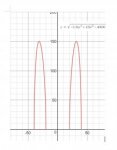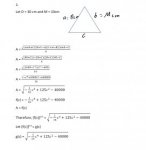Hello phob16:
Overall, your work looks good. I see a couple decisions need correcting and notation/wording issues; you misread the bit about 'polynomial', and your graph contains an error. Let's cover these issues.
… The magnitude of side length C …
c and C are two different symbols. Generally, we use uppercase letters for the triangle's angles (and/or vertices) and we use lowercase letters for side lengths. These rules aren't etched in stone (i.e., you're free to choose your own symbols, when they haven't been provided), but don't use two different symbols to represent the same thing.
… Anything outside the domain will not form a triangle as the length given is too big or small.
Very good. Knowing two sides (30 and 10), we can immediately say side c must be greater than 20 and less than 40. See
this page, for the Triangle Inequality Theorem; they refer to it as, "Triangle inequality", so you may search the page for that name. Each side of a triangle must be less than the sum of the other two sides.
… I've managed to conclude that the zeros create a restriction for the domain that the side length [c] can exist as …
Yes, you correctly found the zeros of the functions: {-40, -20, 20, 40}. Throw away those negative values; they are not consistent with your use of g(c), as discussed below. They are extraneous information.
Your graph is plotted in Quadrants I and II. There are no negative side lengths, so there ought to be no graph in Quadrant II.
The Triangle Inequality Theorem tells you: 20 < c < 40. Any other value for the length of side c will not form a triangle. I don't see a need to include the origin, either. The relevant graph is over the domain of function g(c).
In your own words, what does the graph of g(c) m͏͏ean to you? Can you state function g's domain and range? I would include statements about each of those sets, in your description of the graph.
Technically this should not be a polynomial however the question states that it is …
You've misread that part. They're referring to the function f(c). It's the polynomial, not g(c). The area function g(c) models the triangle's area as the principal square root of a 4th-degree polynomial. (Note the word 'principal' -- we need the positive square root, to model area.)
Overall, I think you've done good work. You just need to tidy up some details. Let us know, if you have any more questions. Cheers :cool:


